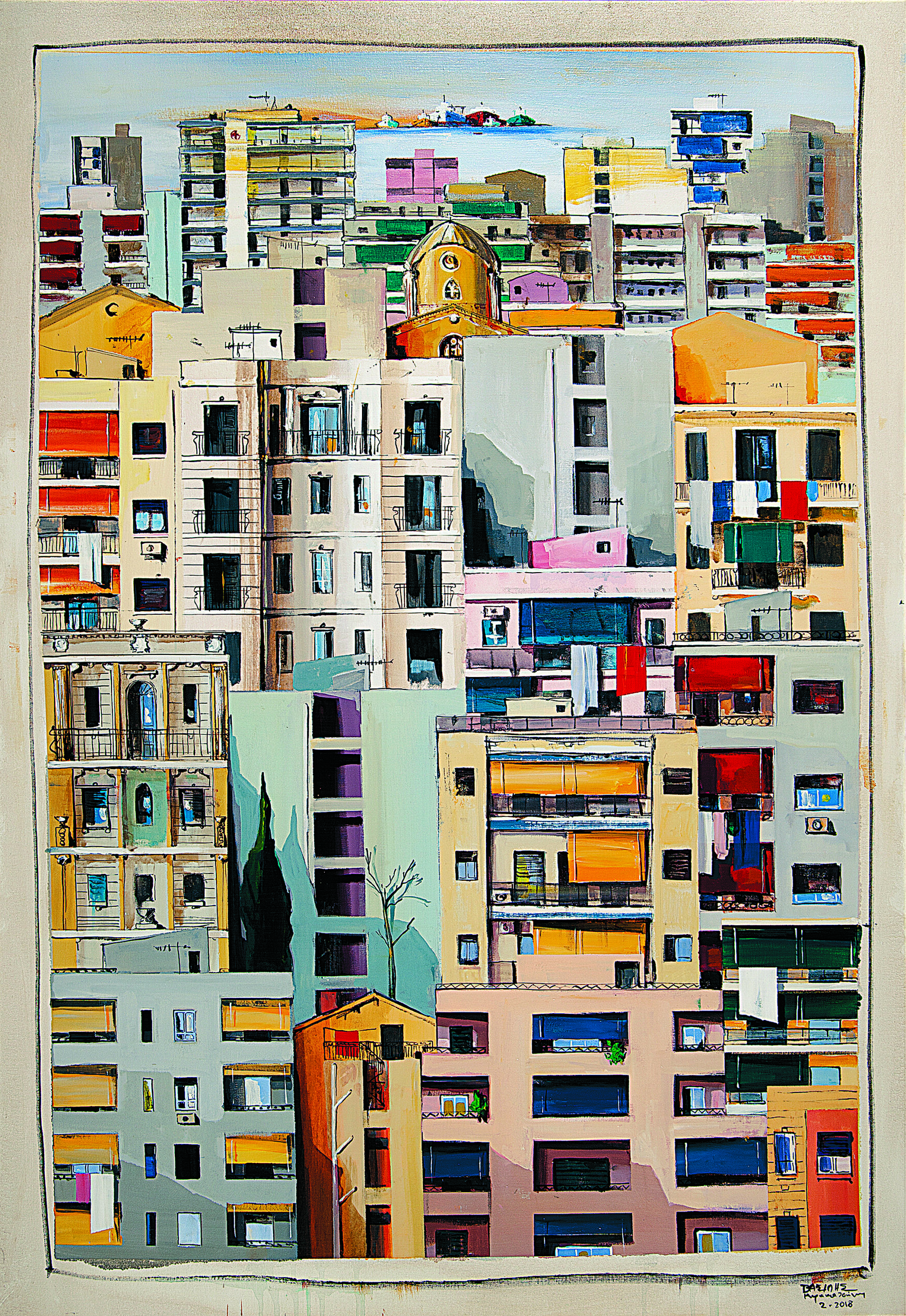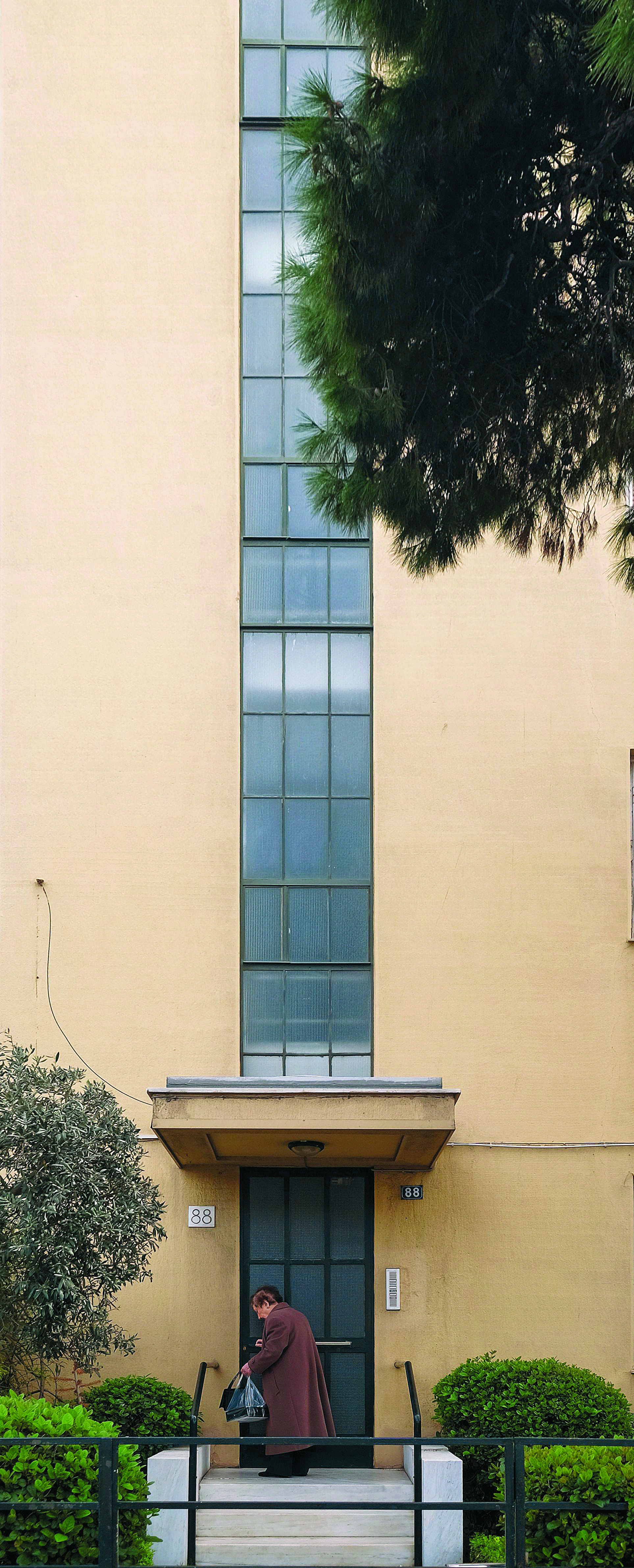
The opening of the large, rich, eventful and multi-faceted art exhibition of the apartment building on Wednesday afternoon on the first floor of the Hellenic American Union has become a real celebration of Athens, the Greek city and its most characteristic architectural expression. The large turnout, despite the particularly turbulent and rainy weather of the day, testifies to the emotional displacement that the predominantly Greek architectural type possesses (and seems to increase every year), judging by the presence of many young people on the first day. exhibitions edited by journalist and writer “K” Nikos Vatopoulos and art critic Iris Kritikou. Painting, sculpture, installation, video and photography interact with testimonies, models, memorabilia and other archival material to co-formulate a complex narrative of living experience.
Watching the continuous flow of people coming and going from one exhibition space to another (Kennedy and Nikos Hatsikiriakos-Ghikas) and especially the excitement on their faces, you immediately understand how far we have come as a society since the tenement house was synonymous with the destruction of the pre-war (and idealized) Greek city, demonized counter-security, and urban ugliness. The bold and (as a result) extremely effective idea of the constant intersection and coexistence of visual works and photography further fueled the communicating vessels of emotional identification with the apartment building that now seem to traverse most generations of Greek society today. The discovery of a continuous “dialogue” between artists (Giorgos Rorris, Io Angeli, Rania Ragout, Tasos Mantsavinos, Minas Kambitakis, etc.) and photographers (Giorgis Gerolimpos, Enri Tzanai, Cleopatra Haritou, Eni Koukoulas, etc.) set the creators and simple flaners cities that nevertheless have an eye and photographic talent, among the living and the inanimate (Giorgos Zongolopoulos, Alekos Fasianos, etc.), outstanding and promising, have multiplied the shock wave of a privileged subject that moves and unites.

Painting, sculpture, installation, video and photography at the service of a complex narrative that moves and connects.
In addition, acting architects will be present with their works, as well as prominent figures of architectural thought (Dimitris Philippidis, Kostas Tsiabaos, Lukas Bartatilas, etc.), as well as two of the three speakers of the parallel program of events that will unfold until the end of the exhibition in the last day of January, another evidence of the multi-prismatic approach chosen by the curators: Andreas Giakumakatos (his speech is scheduled for 8.12), Stathis Kalivas (19.12). The program of speeches ends with the director Maria Iliu (01/11/2023) and an open round table on January 26. Thus, we are dealing with a non-academic exhibition that is in no way aimed exclusively at the architectural community, but is calculated to mobilize a much wider audience based on a shared experience. The architecture of the exhibition follows more or less recognizable routes: for example, in the Ghika Hall, the night view of Giorgos Rorris in the background of the space is the culmination of an artistic “choreography” that develops into other, atmospherically connected, night views. In the Kennedy Room, very characteristic, imposing yuppie poetry, signed by Giannis Bekiaris, converses with the work of Alekos Fasianos and a series of tenements from the interwar period.
The opening of the exhibition of the Greek American Union, which is supported by the Athens Association, was honored by the presence of the Minister of Labor and Social Affairs, Kostis Hatsidakis, and the MP from New Democracy, professor of international relations. Dimitris Kairidis. During the two months that the exhibition will last, in addition to the speeches already mentioned, both excursions and educational programs are planned to intensify the public discussion around the still controversial phenomenon of the Greek urban experience, at the same time mobilize, as Nikos Vatopoulos notes, “fans of visions from architecture, social sciences, art and personal experience of each.
views
Modern Greek palimpsest
Statis N. Kalivas
The history of an apartment building and the evolution of its perception over time constitute a multidimensional field in which critical aspects of our historical and sociological self-consciousness are formed, fit in and revised. The following diagram reflects its basic dynamics as I understand them.
1927-1940: The tenement house is born along with the new urban layers of the interwar period. Its initial dissemination expresses a strong desire to participate equally in the most modern trends of the time, whether it be cutting-edge aesthetic pursuits (Modern Movement) or innovative technical challenges (reinforced concrete).
1940-1950: Construction stops due to war and occupation. According to relevant evidence, a significant proportion of the thousands of hostages taken by the KPD in December 1944 came from the urban tenement houses of Exarchia, Kypseli and Patisia that we know today.
1950-1975: The apartment building becomes the main driving force behind the post-war transformation of Greek society from rural to urban. The invention of consideration allows the development of people’s capitalism, the successful implementation of the mass internal movement of people. The apartment building becomes an instrument of social mobility, a matrix from which the new Greek society is born.
1975-2010: The gradual decline of the construction fever of the previous period is accompanied both by the proliferation of apartment buildings in the suburbs with a new typology of the middle class, and its complete obsolescence with the dominance of an ideology that identifies the countryside “tradition” with genuine populism and “concrete” with the pathology of life in the big city. The apartment building is designated as the ultimate evil.
2010-: The economic crisis leads to the complete collapse of construction activities, the erosion of the general life of an apartment building and the complete obsolescence of the city fund of Athens. However, the crisis will become an occasion for a radical revision of ideas about an apartment building in a positive direction. Can we use this new definition of values to rethink the future of the Greek city?
The architecture of “merchant houses”
Andreas Gyakumakatos*
“Horizontal real estate” is the creation of the second government of Venizelos in the late 1920s. Immediately after this, the apartment buildings that first appeared in the center of Athens are rather an expression of the Europeanization and ecstasy of Greek society. The owner of the land is usually identified with the owner of the building, and the architect is usually the competent operator of the language of modern architecture.
The typology of a high-rise building or residential complex can take a variety of forms. The fact that in Greece the word “apartment building” automatically refers to a certain type of building (as do the words “open”, skylight, living room, studio, penthouse, etc.) has to do with the systematized post-war contract manufacturing. The apartment building was the result of poverty, want, and the almost complete absence of a government housing policy.
However, the “invention” of consideration is not exclusively a Greek phenomenon. It is also observed in other countries, primarily in the European Mediterranean, with the corresponding characteristics of social solidarity and exchange within it. The difference is that in Greece the production of a residence – and by extension a city – was based almost exclusively on this “private” process. Another difference is that regulation of the site and urban infrastructure elsewhere preceded the construction of the facilities.
The high-yield housing industry in Greece was the main driver of growth in the context of post-war reconstruction. This justified any government tolerance. The various actors in the case, site owners, builders and brokers, acted with the sole motive of profit maximization. This is not a collective design activity, as claimed, but a profitable standardized mass production of what the architects of the time called “merchants’ houses.” The phenomenon is worthy of study from an anthropological or social point of view (amateur activity-property-public recognition), but it does not cease to be a process of producing low-quality housing and a residential and urban environment, sometimes at the limit of possibilities. sustainability.
* Mr. Andreas Giakumakatos is Professor of Architecture at the School of Fine Arts.

Source: Kathimerini
Ashley Bailey is a talented author and journalist known for her writing on trending topics. Currently working at 247 news reel, she brings readers fresh perspectives on current issues. With her well-researched and thought-provoking articles, she captures the zeitgeist and stays ahead of the latest trends. Ashley’s writing is a must-read for anyone interested in staying up-to-date with the latest developments.